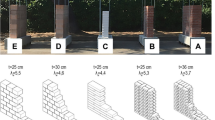Abstract
In the case of masonry structures subjected to seismic loads, shear failure mechanism of walls, characterised by the formation of diagonal cracks, by far predominates the sliding shear failure mechanism. However, as assumed by Eurocode 6, the latter represents the critical mechanism for the assessment of the shear resistance of structural walls. The results of a series of laboratory tests are analysed to show that in the case of the diagonal tension shear failure the results of the Eurocode 6 based calculations are not in agreement with the actual resistance of masonry walls. The results of calculations, where the diagonal tension shear mechanism and tensile strength of masonry are considered as the critical parameters, are more realistic. Since the results of seismic resistance verification, based on the Eurocode 6 assumed sliding shear mechanism, are not in favour of structural safety, it is proposed that in addition to sliding shear, the diagonal tension shear mechanism be also considered. Besides, in order to avoid misleading distribution of seismic actions on the resisting shear walls, the deformability characteristics of masonry at shear should be determined on the basis of experiments and not by taking into account the Eurocode 6 recommended G/E ratio.













Similar content being viewed by others

References
CEN (2000) Methods of tests for masonry units—part 1: determination of compressive strength. EN 772-1:2000. Brussels
CEN (2005) Eurocode 6: design of masonry structures—part 1-1: common rules for reinforced and unreinforced masonry structures. EN 1996-1-1:2005. Brussels
Meli R (1973) Behavior of masonry walls under lateral loads. In: Proceedings of the 5th world conference on earthquake engineering. International Association for Earthquake Engineering, Rome, paper 101a
Priestley MJN, Bridgeman DO (1974) Seismic resistance of brick masonry walls. Bull N Z Nat Soc Earthq Eng 7(4):167–187
Mayes RL, Omote Y, Clough RW (1976) Cyclic shear tests on masonry piers, vol 1. Report No. UCB/EERC 76-8. Earthquake Engineering Research Center, Berkeley
Terčelj S, Turnšek V, Tomaževič M, Sheppard P (1980) Le ricerche di laboratorio sui problemi del recupero strutturale dell’ edilizia preesistente in zone sismiche. Ricostruire, 10/11, Martin Internazionale, Udine, pp 29–34
Tomaževič M, Lutman M, Petković L (1996) Seismic behavior of masonry walls: experimental simulation. J Struct Eng ASCE 122(9):1040–1047. doi:10.1061/(ASCE)0733-9445(1996)122:9(1040)
American Society for Testing and Materials (1998) Test method for conducting strength tests on panels for building construction. ASTM E72
Sheppard P, Tomaževič M (1985) Možnosti revizalizacije stanovanjskih zidanih zgradb z aspekta potresne varnosti (Possibilities of revitalization of residential masonry buildings regarding the seismic safety). Report ZRMK, Ljubljana
International Council for Building (1987) International recommendations for design and erection of unreinforced and reinforced masonry structures. Publication 94, Rotterdam
Drysdale RG, Hamid AA, Baker LR (1999) Masonry structures. Behavior and design. The Masonry Society, Boulder
Magenes G, Bolognini D, Braggio C (2000) Metodi simplificati per l’analisi sismica non lineare de edifici in muratura. CNR-Gruppo Nazionale per la Difesa dai Terremoti, Rome
Bernardini A, Modena C, Turnšek V, Vescovi U (1980) A comparison of three laboratory test methods used to determine the shear resistance of masonry walls. In: Proceedings of the 7th world conference on earthquake Engineering, vol 7. International Association for Earthquake Engineering, Istanbul, pp 181–184
Turnšek V, Čačovič F (1971) Some experimental results on the strength of brick masonry walls. In: Proceedings of the 2nd international brick-masonry conference. British Ceramic Society, Stoke-on-Trent, pp 149–156
Mann W, Müller H (1982) Failure of shear-stressed masonry—an enlarged theory, tests and application to shear walls. In: Proceedings of the British Ceramic Society, No. 30, Shelton House, Stoke-on-Trent 1982, pp 223–235
Magenes G, Calvi M (1997) In-plane seismic response of brick masonry walls. Earthq Eng Struct Dyn 26:1091–1112. doi :10.1002/(SICI)1096-9845(199711)26:11<1091::AID-EQE693>3.0.CO;2-6
Regione Autonoma Friuli Venezia-Giulia (1977) Raccomandazioni per la riparazione strutturale degli edifici in muratura. Legge Regionale 20 giugno 1977, no. 30
Technical regulations for the construction of buildings in seismic regions (1981) Official Gazette of SFR Yugoslavia No. 31, Beograd
Tomaževič M, Weiss P (2008) The influence of robustness of hollow clay blocks on seismic behaviour of masonry walls. Test results. Report ZAG/0964/04-1. Slovenian National Building and Civil Engineering Institute, Ljubljana
CEN (2002) Methods of tests for masonry—part 3: determination of initial shear strength. EN 1052-3:2002. Brussels
CEN (1998) Methods of tests for masonry—part 1: determination of compressive strength. EN 1052-1:1998. Brussels
Tomaževič M (1978) Improvement of computer program POR. Report ZRMK-IK, Ljubljana (in Slovene)
Tomaževič M, Turnšek V (1982) Verification of the seismic resistance of masonry buildings. In: Proceedings of the British Ceramic Society. No. 30. Shelton House, Stoke-on-Trent, pp 360–369
CEN (2004) Eurocode 8: design of structures for earthquake resistance, part 1: general rules, seismic actions and rules for buildings. EN 1998-1:2004. Brussels
Acknowledgement
The study has been based on the results of the recent experimental research, carried out within the framework of the research program P2-0274, financed by the Slovenian Research Agency in the years 2003–2008.
Author information
Authors and Affiliations
Corresponding author
Rights and permissions
About this article
Cite this article
Tomaževič, M. Shear resistance of masonry walls and Eurocode 6: shear versus tensile strength of masonry. Mater Struct 42, 889–907 (2009). https://doi.org/10.1617/s11527-008-9430-6
Received:
Accepted:
Published:
Issue Date:
DOI: https://doi.org/10.1617/s11527-008-9430-6



